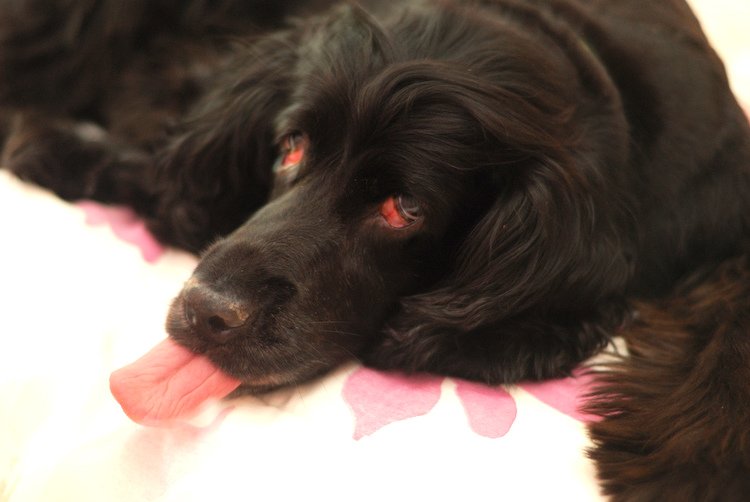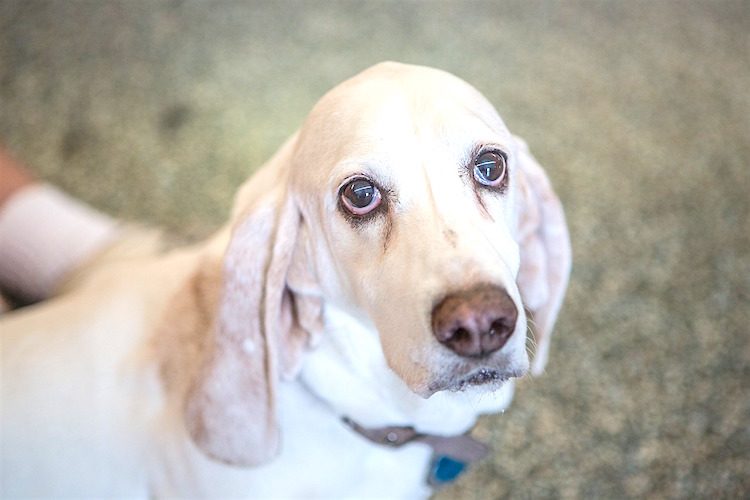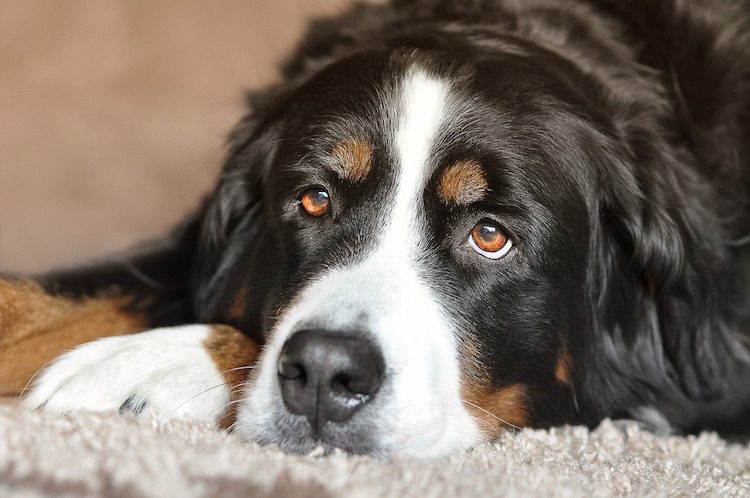
Ectropion in dogs is the term used for droopy eyelids, or eyelids that roll out or evert, and extreme cases may require treatment.
The classic picture that comes to mind is the droopy eyes associated with breeds such as Bloodhounds and Basset Hounds.
In certain breeds, a degree of ectropion is considered normal. When the droop is excessive, causing problems or occurring in breeds with no predilection for ectropion, it is considered an ophthalmic problem.
What Causes Ectropion in Dogs?
Ectropion (eyelids rolling out) is the opposite of entropion (rolling in of the lid).
A lot of people ask, “Is ectropion in dogs hereditary?” And, sometimes, yes: Ectropion is most commonly an inherited and breed-related problem. This form affects only the lower lids.
Secondary or acquired ectropion is much less common and can occur in the upper or lower lids. Acquired ectropion can result from:
- Trauma. Scarring of the eyelid from any trauma, burns or surgical procedures, such as overcorrection in entropion surgery, can result in ectropion.
- Facial nerve paralysis can cause ectropion on the affected side of the face.
- Mild ectropion can worsen as a dog ages due to muscle weakening.
- Transient ectropion may be associated with fatigue.

Problems Associated With Ectropion in Dogs
A normal eyelid protects the eye from injury, keeps the eye clean, provides proper lubrication of the eye and shields the eye from the elements and trauma. A very droopy lower eyelid increases the risk of the eye becoming inflamed, injured or dry.
Ectropion can also lead to conjunctivitis. If the lower lid is saggy, the conjunctiva is exposed and can become inflamed.
Diagnosis of Ectropion
Diagnosis is straightforward. Your vet can determine that the eyelid appears longer than normal with a sag in the center, exposing the conjunctiva.
There may be associated conjunctivitis or corneal problems in severe cases of ectropion.
Hereditary ectropion is diagnosed in young dogs whereas acquired ectropion can occur at any age.
Dog Breeds Associated With Ectropion
- American and English Cocker Spaniel
- Basset Hound
- Bernese Mountain Dog
- Bloodhound
- Bouvier des Flandres
- Boxer
- Chow Chow
- Clumber Spaniel
- Dogue de Bordeaux
- English Bulldog
- English Setter
- English Springer Spaniel
- Gordon Setter
- Great Dane
- Great Pyrenees
- Labrador Retriever
- Leonberger
- Mastiff
- Neapolitan Mastiff
- Newfoundland
- Saint Bernard
Some of these breeds, like the Saint Bernard, for example, can have combined ectropion and entropion, often requiring surgical correction. The lids at the inner corners of the eye can turn inward (entropion), while the middle of the lid everts (ectropion).

How Do You Treat Ectropion in Dogs?
For mild ectropion in dogs, treatment may not even be required. If the slight droop in the lid doesn’t lead to any ocular problems, such as recurrent conjunctivitis or dry eye, then we leave it alone.
Serious cases, however, require reconstructive eyelid surgery.
Medical Treatment
If a dog suffers from mild dry eye or occasional conjunctivitis because of ectropion, topical ophthalmic medications and/or eye lubricants are usually sufficient to keep the problems under control. This is variable, however, from dog to dog.
Here are some things to consider when controlling your dog’s ectropion:
- Have your vet or veterinary ophthalmologist check any chronic eye problem at least twice a year. Common sense dictates that more serious conditions may mean eye rechecks every 3 months.
- Ectropion can worsen with age. The laxity in the lids usually increases over the years and facial muscles lose their strength. A dog may have ectropion managed medically for years but go on to need surgery when older.
- Chronic problems caused by ectropion — like conjunctivitis, dry eye or corneal damage — can also worsen with time. People might tire of administering eye medications or making continual vet appointments. It’s a part of human nature that people can become lax when dealing with a problem for years. “Oh, that eye looks really red again, but it will be OK,” I’ve heard, or, “Well, there’s a lot more eye discharge now, but I’m just going to wait a while.” This can be dangerous. Don’t turn a blind eye to a red eye.
Surgical Treatment for Ectropion in Dogs
Ectropion surgery is indicated if the associated problems of conjunctivitis, extreme ocular discharge or corneal problems are severe enough to warrant surgical intervention. The surgery is most frequently performed when the entropion/ectropion combo exists.
Was YOUR Pet Food Recalled?
Check Now: Blue Buffalo • Science Diet • Purina • Wellness • 4health • Canine Carry Outs • Friskies • Taste of the Wild • See 200+ more brands…

Recovery from surgery is similar to entropion surgery: The dog wears an Elizabethan collar for about 7–10 days, and is prescribed some ophthalmic ointments and pain meds.
Some people with dog breeds predisposed to ectropion, such as Bassett Hound or Bloodhound lovers, resist surgery because they like “the look” of the droopy eye. Surgical correction can be done in these breeds if necessary to alleviate ocular problems but leave the dog with enough of a mild ectropion to keep the breed-associated aesthetic look.
This brings up an ethical matter that breeders must consider. Ectropion has probably been made worse in many breeds because of AKC language and people breeding dogs with too much ectropion.
The AKC standard for the Basset Hound, for example, states, “The eyes are soft, sad and slightly sunken, showing a prominent haw …”
The haw is a layman’s term for a dog’s nictitating membrane, or third eyelid. Basset people call this “the flick of the haw.” To expose the haw and achieve that “soft, sad and slightly sunken” look, you are breeding ectropion.
As in so many hereditary conditions, we humans can make things worse by trying to accentuate a certain trait — in this case, a sadder, softer, more sunken look. We end up with Bassets whose ectropion must be surgically corrected, just like Pugs who need surgery to breathe!

Surgery Is a Specialty
Ectropion surgery for dogs is usually very effective and prognosis is excellent — but as with entropion correction, there is a true art to this kind of ophthalmic surgery.
Several different procedures on the same eyelid may be needed to fix a complicated case. In severely affected eyes, multiple surgeries may be needed. Laxity of the eyelids continues throughout life, possibly requiring additional surgeries.
The average canine eyelid is about 33 mm. Many Bloodhounds have lengths of 50 mm. The goal of surgery is to relieve any problems associated with the overlong lids as well as to have a nice and matching cosmetic result.
The upper lid may have to be fixed as well to ensure a healthy eye. Because of the intricacies involved in these surgeries and the fact that multiple surgeries may be needed, referral to a veterinary ophthalmologist who specializes in lid surgery is a spectacular idea.
My Cat With Ectropion
Although very rare, yes, cats can get ectropion, and it is always acquired. As in dogs with acquired ectropion, it results from trauma, chronic inflammation, scarring, muscle loss, aging and other causes.
As a first-year student in vet school, I was worried about my own cat, Homer, who had a conjunctivitis I just couldn’t clear up with the typical medications.
Lucky enough to get an appointment with the top ophthalmologist at Penn, Dr. Eyebright diagnosed my Homer with conjunctivitis secondary to moderate ectropion. He explained it this way, and I never forgot it:
“An animal with moderate to severe ectropion winds up having 2 garbage cans for eyes with no lids to keep the garbage out. In other words, as the eyelids droop, you have 2 little pockets under the eye that can fill up with tiny debris instead of an eyelid that appropriately meets the eye, creating a seal of protection.”
I hadn’t noticed the ectropion in the cat — just the resulting conjunctivitis. Nor did I pick up on the fact that my cat just didn’t look so healthy, according to Dr. Eyebright. He said the conjunctivitis wasn’t that serious, but since ectropion was not common in cats, we had to get to the bottom of why the cat had acquired little garbage cans beneath his eyes.
It turned out that poor Homer had been losing weight and losing muscle in his face and body as well as had chronic conjunctivitis, all related to the feline leukemia virus.
With supportive care, he lived to be 12 — not too bad for a cat with clinical leukemia virus.
Meet Smartie Pants, the young Basset Hound who developed ulcers from her eye problems:

This experience has stayed with me throughout my own career. It taught me that people (including vet students) might care deeply about their pets but not notice subtle or even moderate changes in their pet, like weight loss and droopy eyelids.
It also taught me to always look at the whole animal, not just the presenting complaint of the client.
Here’s the take-home message if you have a pet with ectropion:
- If the ectropion is hereditary, monitor the condition and the problems it causes throughout your pet’s life.
- If your animal acquires ectropion, it’s important to find out what caused it.
Eyes are not as forgiving as other body parts when it comes to chronic conditions or trauma. Protect your pet’s vision by being attentive to any changes in those big, beautiful loving eyes.
References
- La Croix, Noelle, DVM. VIN Discussions on Ophthalmology Board. 2017–2018.
- Maggs, David, BVSc (Hons), DAVCO. “Eyelids.” Slatter’s Fundamentals of Veterinary Ophthalmology, 5th ed. Elsevier. 2012.
- Ward, Ernest, DVM. “Eyelid Ectropion in Dogs.” VCA Hospitals. 2009. https://vcahospitals.com/know-your-pet/eyelid-ectropion-in-dogs.
 This article on ectropion in dogs and treatment was written by a veterinarian, Dr. Debora Lichtenberg, VMD. It was last reviewed Feb. 5, 2019.
This article on ectropion in dogs and treatment was written by a veterinarian, Dr. Debora Lichtenberg, VMD. It was last reviewed Feb. 5, 2019. 

